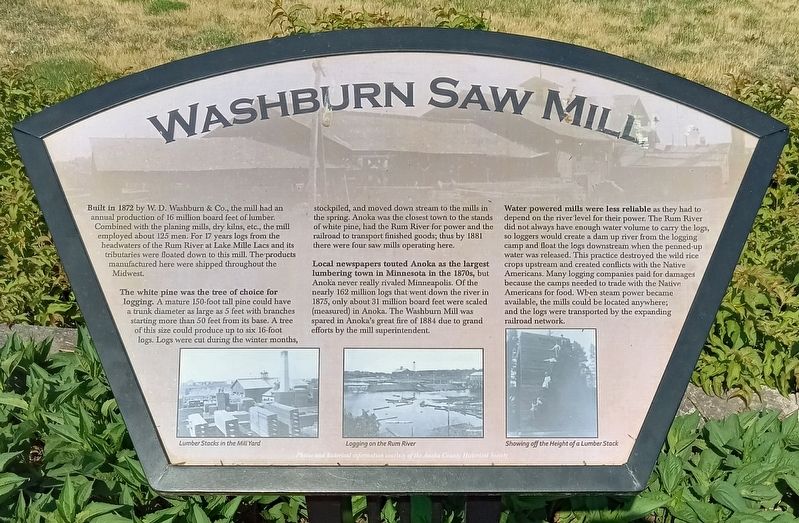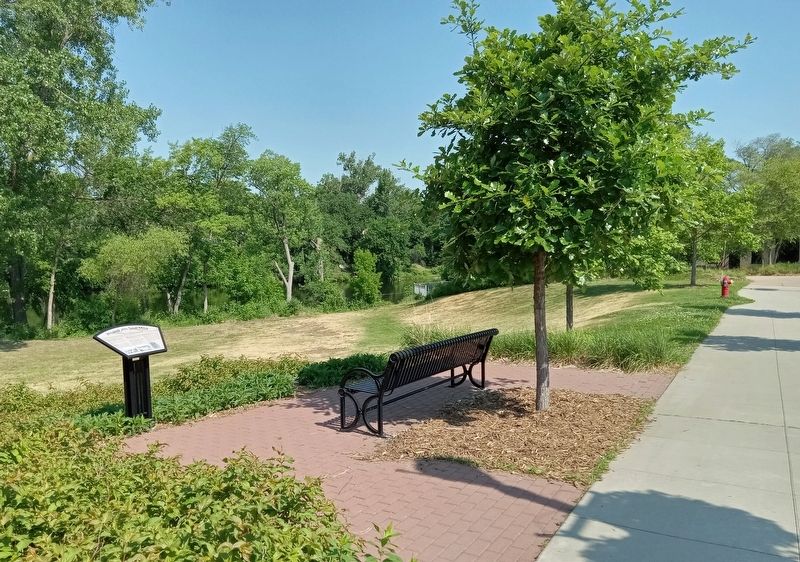Anoka in Anoka County, Minnesota — The American Midwest (Upper Plains)
Washburn Saw Mill
Built in 1872 by W.D. Washburn & Co., the mill had an annual production of 16 million board feet of lumber. Combined with the planing mills, dry kilns, etc., the mill employed about 125 men. For 17 years logs from the headwaters of the Rum River at Lake Mille Lacs and its tributaries were floated down to this mill. The products manufactured here were shipped throughout the Midwest.
The white pine was the tree of choice for logging. A mature 150-foot tall pine could have a trunk diameter as large as 5 feet with branches starting more than 50 feet from its base. A tree of this size could produce up to six 16-foot logs. Logs were cut during the winter months, stockpiled, and moved down stream to mills in the spring. Anoka was the closest town to the stands of white pine, had the Rum River for power and the railroad to transport finished goods; thus by 1881 there were four saw mills operating here.
Local newspapers touted Anoka as the largest lumbering town in Minnesota in the 1870s, but Anoka never really rivaled Minneapolis. Of the nearly 162 million logs that went down the river in 1875, only about 31 million board feet were scaled (measured) in Anoka. The Washburn Mill was spared in Anoka's great fire of 1884 due to grand efforts by the mill superintendent.
Water powered mills were less reliable as they had to depend on the river level for their power. The Rum River did not always have enough water volume to carry the logs, so loggers would create a dam up river from the logging camp and float the logs downstream when the penned-up water was released. This practice destroyed the wild rice crops upstream and created conflicts with the Native Americans. Many logging companies paid for damages because the camps needed to trade with the Native Americans for food. When steam power became available, the mills could be located anywhere; and the logs were transported by the expanding railroad network.
(captions:)
Lumber Stacks in the Mill Yard
Logging on the Rum River
Showing off the Height of a Lumber Stack
Photos and historical information courtesy of the Anoka County Historical Society
Topics. This historical marker is listed in these topic lists: Industry & Commerce • Native Americans • Waterways & Vessels. A significant historical year for this entry is 1872.
Location. 45° 12.062′ N, 93° 23.372′ W. Marker is in Anoka, Minnesota, in Anoka County. Marker is on 2nd Avenue south of Harrison Street, on the right when traveling south. Touch for map. Marker is at or near this postal address: 2201 2nd Avenue, Anoka MN 55303, United States of America. Touch for directions.
Other nearby markers. At least 8 other markers are within walking distance of this marker. Rum River Dam (about 600 feet away, measured in a direct line); Father Louis Hennepin's Exploration in 1680 (approx. ¼ mile away); Aaron Greenwald (approx. ¼ mile away); Anoka Post Office (approx. ¼ mile away); The Stone House (approx. ¼ mile away); Robert W. Akin (approx. ¼ mile away); Perseverance Needed (approx. 0.3 miles away); Windego Park Auditorium (approx. 0.3 miles away). Touch for a list and map of all markers in Anoka.
Credits. This page was last revised on March 5, 2024. It was originally submitted on March 4, 2024, by McGhiever of Minneapolis, Minnesota. This page has been viewed 57 times since then. Photos: 1, 2. submitted on March 4, 2024, by McGhiever of Minneapolis, Minnesota. • Andrew Ruppenstein was the editor who published this page.

